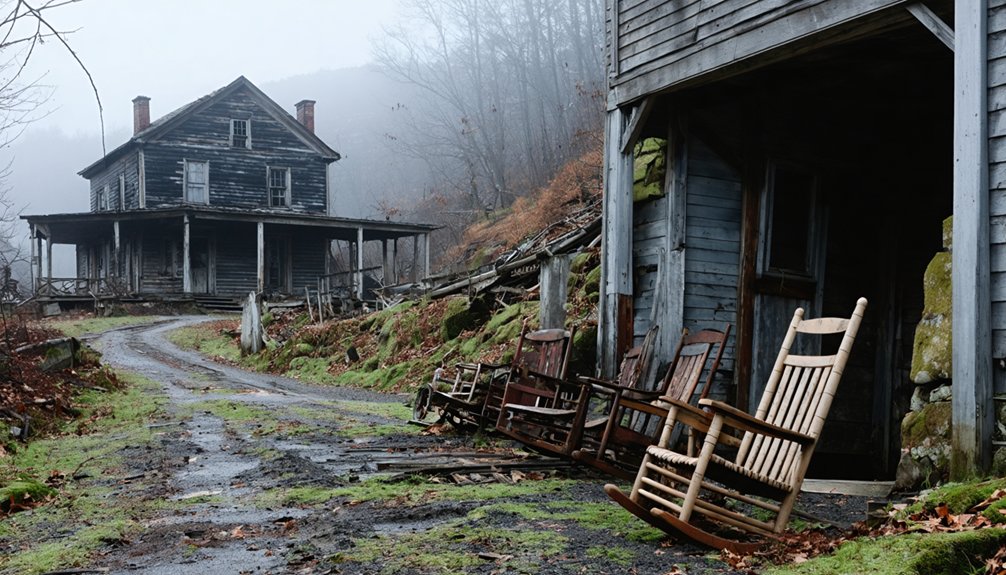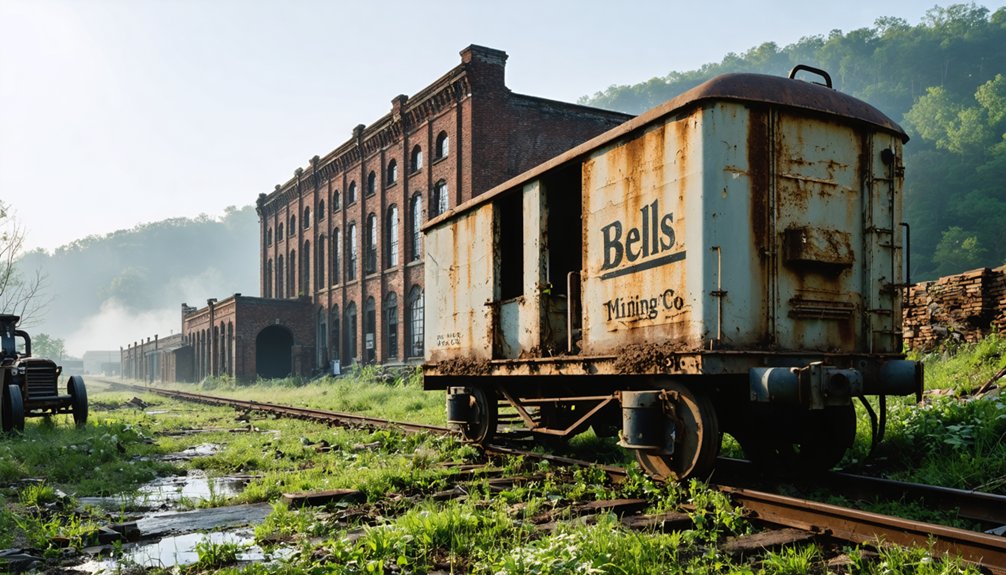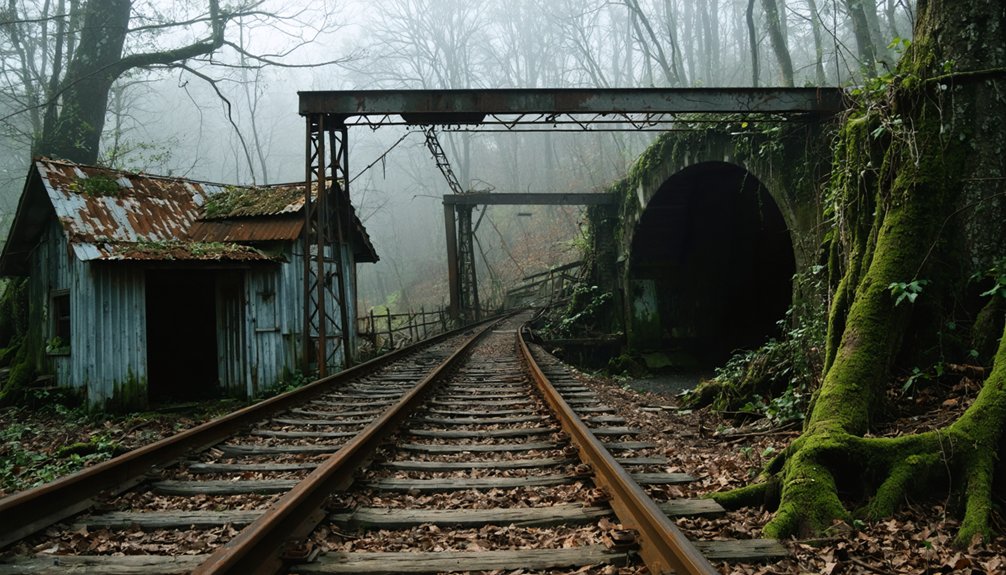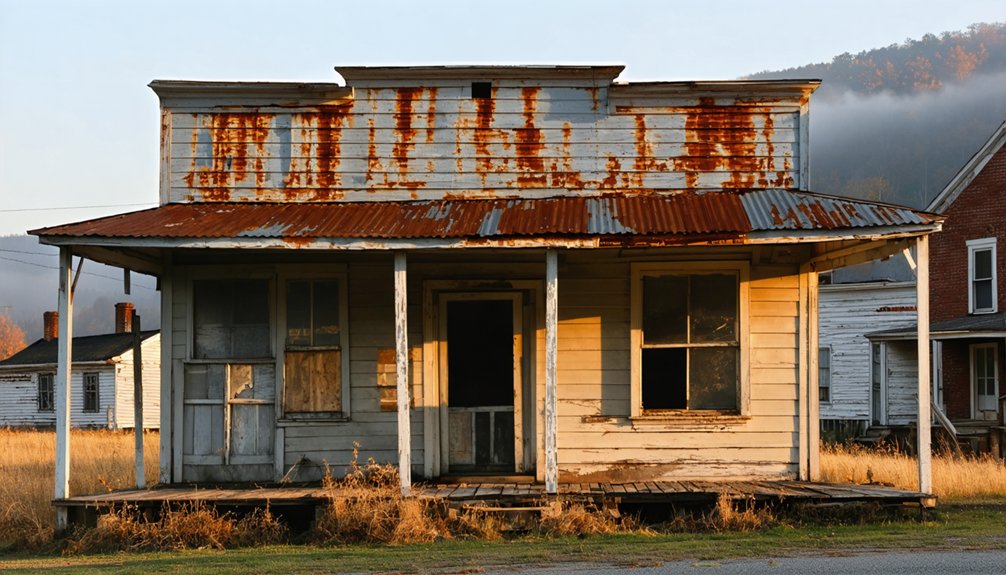You’ll discover Bells Mines tucked along Kentucky’s Tradewater River, where John Bell’s 1836 coal venture transformed quiet farmland into a bustling mining town. The arrival of European immigrants and the L&N Railroad in 1888 brought unprecedented growth, with daily coal production reaching 800 tons by 1910. Today, the abandoned town’s cemetery tells stories through its headstones, while the surrounding landscape holds secrets of Kentucky’s industrial heritage.
Key Takeaways
- Bells Mines began as a thriving coal mining community in 1836 when John Bell established operations along the Tradewater River.
- The town experienced significant growth with the arrival of the L&N Railroad in 1888, reaching peak production of 800 tons daily by 1910.
- European immigrants formed the backbone of the mining community, creating tight-knit ethnic enclaves around the coal operations.
- The Bells Mines Cemetery remains as a historical marker, preserving the community’s diverse cultural heritage through its headstone inscriptions.
- Mine closures and resource depletion led to population decline, transforming the once-bustling mining town into an abandoned settlement.
The Origins of a Mining Community (1810s-1836)
While farmers from Virginia and the Carolinas first settled the fertile lands between Sturgis and Marion, Kentucky in the early 1800s, they couldn’t have predicted how the discovery of coal would transform their agricultural community.
You’ll find the area’s community formation was shaped by its strategic location near the Ohio River, which proved essential for early trade and settlement.
The region’s abundant natural resources, particularly coal deposits, laid the foundation for its mining heritage. What started as scattered farmsteads soon evolved as settlers recognized the economic potential beneath their feet.
The land’s proximity to waterways made it an ideal location for establishing a permanent settlement, setting the stage for the dramatic changes that would unfold in the decades ahead. In 1836, the purchase of thirty-one acres along the Tradewater River would prove instrumental in developing the area’s mining operations. The establishment of mining operations by John Bell in 1842 marked the beginning of the area’s transformation into a thriving coal mining community.
John Bell’s Vision and Mining Legacy
You’ll find Bell’s vision for coal mining took shape in 1836 when he purchased 31 acres near the Tradewater River to establish what would become one of western Kentucky’s oldest mining communities.
Though Bell rarely visited the mines personally, he appointed trusted managers like W.C. Carvell and his son John Bell Jr. to oversee the operations that became renowned for producing high-quality coal. The mines gained prominence during his time as a Tennessee Congressman, serving the region’s growing industrial needs.
The Bell legacy lived on through the Bell Coal and Navigation Company, which reopened the mines in the mid-1920s after a 70-year pause in operations. The company’s ambitious expansion included plans for a 500 horsepower plant and modern coal processing facilities.
Early Mining Operations Established
In 1836, ambitious Tennessee politician John Bell launched one of Kentucky’s earliest organized coal mining ventures near the Tradewater River in northern Crittenden County. He purchased 31 acres from John Lamb and John Rourk, quickly establishing what would become known as Bells Mines.
The early mining techniques focused on shaft development, with operations expanding rapidly to meet growing coal demand. The mine would later be surpassed in production by operations like those of Thomas J. Asher, who achieved an impressive 4,000 tons daily output.
You’ll find it fascinating that Bell’s mines produced some of Kentucky’s highest quality coal, attracting skilled immigrant laborers from across Europe. Workers from Germany, France, England, Scotland, Ireland, and Wales brought their mining expertise to the operation.
While Bell managed the venture from afar through paid managers, the coal was initially transported by wagon to nearby markets like Sturgis, until railroad branches were later constructed to improve distribution.
Bell’s Management Style
Despite his ambitious vision for the mining venture, John Bell maintained a hands-off approach to daily operations at Bells Mines after establishing the enterprise in 1836. His management delegation strategy placed trusted agents like W.C. Carvell in charge while he pursued his political career.
You’ll find his influence reflected in the formal trust arrangements he created in 1847 to guarantee the mines’ continued operation. Under this system, the operation flourished with modern improvements, including a 500-horsepower power plant, wash plants, and employee housing.
Bell’s political influence helped secure investments while his appointed managers, including William Herbert, maintained high operational standards. Even after Bell’s death in 1867, his legacy continued through Carvell’s leadership, preserving both the industrial progress and community development he’d envisioned.
Legacy Through Bell Company
Although John Bell spent limited time at his mining venture, his founding vision in 1836 created an enduring legacy that shaped northern Crittenden County’s industrial landscape for generations.
His strategic purchase of 31 acres along the Tradewater River set the foundation for what would become one of Kentucky’s most significant mining operations.
Bell’s influence extended far beyond his lifetime, as evidenced by the Bell Coal and Navigation Company‘s massive expansion to 5,000 acres in the early 20th century.
You’ll find his legacy in the diverse community that formed around the mines, drawing workers from across Europe and America.
Even after Bell’s death in 1867, his business strategies lived on through trust arrangements that guaranteed the mines’ continued operation, though intermittently, well into the next century.
European Immigration and Cultural Diversity
When Kentucky’s coal industry began its rapid expansion in the late 19th century, European immigrants arrived in large numbers seeking better opportunities and steady work.
You’d find Hungarians, Germans, and Swiss immigrants settling into the coal camps, forming tight-knit ethnic enclaves within the broader mining communities. While cultural assimilation pressures existed, many newcomers maintained their heritage through churches, schools, and mutual aid societies. Some mining communities like Hungarian cooperative Himlerville offered workers unprecedented opportunities through stock ownership. Many immigrants followed the success stories of families who moved north seeking improved wages and living conditions.
Coal companies actively recruited these European workers, sometimes paying their passage and promising higher wages than they’d earn back home.
Though the reality often proved harsher than advertised, with low pay and tough conditions, these immigrant families enriched Kentucky’s coal towns with their distinct architectural styles, traditional foods, music, and festivals.
Their contributions shaped the unique cultural fabric of mining communities like Bells Mines.
Daily Life in a Kentucky Coal Town

Living in a Kentucky coal town meant surrendering nearly every aspect of daily life to company control.
Coal companies ruled with an iron grip, dictating every facet of miners’ existence in Kentucky’s company towns.
You’d wake up in your company-owned house, walk to the company-owned mine, and earn wages partly paid in scrip – money you could only spend at the company store. Your daily routines centered around the mine’s schedule, while company guards watched from hidden treehouses to guarantee you didn’t step out of line. Miners endured ten to twelve hours of grueling work six days a week. Occupational fatalities were tragically common due to roof collapses and gas explosions.
Despite these restrictions, you’d find moments of connection through community gatherings at the local Baptist church, post office, or company commissary.
These spaces became crucial hubs where you’d share news with neighbors and maintain social bonds. While the company controlled your economic freedom through scrip payments and wage deductions, you’d still forge strong community ties that helped sustain hope through the hardships.
The Cemetery: A Window to the Past
When you walk through Bells Mines Cemetery, you’ll find stories etched in stone that reveal the lives of immigrant families who built Western Kentucky’s coal industry.
The headstones serve as historical documents, chronicling the migration patterns of families from Virginia, the Carolinas, and eastern Kentucky who settled this mining community.
Each inscription and monument style reflects the cultural evolution of the region, from simple frontier markers to elaborate Victorian monuments that showcase the growing prosperity of the coal town’s residents. These remarkable stones provide vital genealogical information that helps researchers trace family histories and connections throughout the area.
Cultural Markers Carved Forever
Time stands frozen in the weathered stones of Bells Mines Cemetery, established in the mid-19th century as the final resting place for pioneering Kentucky families.
As you walk among the varied monuments, from simple slabs to ornate marble creations, you’ll find the cultural significance etched into every name and date, telling stories of the Adamsons and other founding families who shaped this land.
Though the town has vanished into the wilderness, the cemetery endures as a powerful keeper of community memory.
Each headstone reveals chapters of local history, from Civil War skirmishes to the boom and bust of coal mining.
You’ll discover how generations of settlers left their mark through inscriptions that speak of triumph, loss, and the untamed spirit of Kentucky’s frontier days.
Immigrant Stories in Stone
Beneath the weathered stones of Bells Mines Cemetery lies a rich tapestry of immigrant heritage, woven through the diverse origins of its coal mining community.
You’ll find stone inscriptions that tell tales of German families from Bavaria and Prussia, alongside markers for those who journeyed from France, England, Scotland, Ireland, and Wales in the 1840s and 1850s.
These immigrant narratives are carved into elaborate marble monuments and simple slabs alike, revealing the social status and achievements of those who built this bustling mining town.
The cemetery’s family plots showcase how European immigrants and American settlers from states like New York and Pennsylvania created a thriving multicultural community.
Today, though the mines are silent, these stones remain as enduring symbols of the courage and determination of those who shaped Kentucky’s early coal country.
Economic Rise and Industrial Development

Although Bells Mines started modestly with John Bell’s 31-acre purchase in 1836, the town’s industrial development quickly gained momentum through a powerful combination of coal discovery, lumber operations, and railroad connectivity.
You’ll find the town’s economic fluctuations reflected in its shift from timber to coal, as sawmills like Rennebaum & Slawson gradually gave way to mining operations by 1910.
The industrial shifts accelerated when the L&N Railroad arrived in 1888, transforming the region’s potential. The mines modernized with electric motors and extensive rail systems, pushing production to 800 tons daily.
Multiple seams of coal, some reaching 60 inches thick across 1,500 acres, promised sustained growth. The town’s infrastructure expanded to match its ambitions, complete with electric plants and efficient tipple systems.
The Path to Abandonment
Despite the promising industrial growth of Bells Mines, the town’s fate began to unravel in the late 19th century through a complex web of challenges.
You’ll find that the town’s heavy reliance on coal proved to be its Achilles’ heel, as market fluctuations and resource depletion gradually eroded its economic foundation.
The social dynamics shifted dramatically when European immigrants, who’d once flocked to the mines for work, began departing as operations suspended.
Once-vibrant immigrant communities scattered to the winds as mine closures forced workers to seek opportunities elsewhere.
Environmental impacts from decades of mining took their toll on the landscape and water quality.
The remote location didn’t help either, making it impossible for the community to pivot toward other industries.
Nature has since reclaimed the area, transforming the once-bustling mining town into a wildlife sanctuary with a rich historical legacy.
Preserving Bells Mines’ Historical Heritage

While much of Bells Mines has faded into Kentucky’s wilderness, dedicated preservation efforts have kept its historical legacy alive through several key initiatives.
You’ll find heritage preservation seamlessly integrated into both cultural and environmental protection programs, especially since the area’s incorporation into the Big Rivers Wildlife Management Area.
- The historic Bells Mines Cemetery serves as an outdoor museum, showcasing diverse tombstone architecture and family histories.
- Federal and state land acquisitions protect both natural habitats and cultural sites.
- Kentucky’s AML Reclamation Program addresses mining heritage while restoring the landscape.
- Local historical societies document and share the area’s significance through publications and tours.
- Community engagement flourishes through educational programs and heritage tourism opportunities.
Frequently Asked Questions
Were There Any Major Mining Accidents or Disasters in Bells Mines?
Like canaries in a coal shaft, mining safety records from Bells Mines are limited, but accident reports show Bell County’s mining deaths continue, with the region’s first Kentucky coal fatality in 2019.
What Happened to the Mining Equipment After the Town Was Abandoned?
You won’t find direct records of the mining equipment’s fate, but it’s likely the machinery was either sold, scrapped for metal, or abandoned to decay – a common outcome in Kentucky’s ghost mining towns.
Are There Any Remaining Structures Besides the Cemetery Still Standing Today?
You won’t find any standing structures in this ghost town today – everything’s gone except the cemetery. The land has returned to nature as part of the Big Rivers Wildlife Management Area.
Did Native Americans Have Any Settlements in the Area Before Mining?
Yes, you’ll find evidence of Native settlements in this area – particularly Cherokee and Mingo tribes established presence near Cumberland Gap, leaving behind rock shelters, artifacts, and clan markings of cultural significance.
What Was the Peak Population of Bells Mines During Its Heyday?
You won’t find specific peak population records for this mining boom town, though regional patterns suggest it likely housed several hundred residents during its most active coal-mining period.
References
- https://kids.kiddle.co/Bells_Mines
- https://www.freakyfoottours.com/us/kentucky/
- https://westernkyhistory.org/crittenden/bellsminescem.html
- http://ourforgottenpassages.blogspot.com/2024/11/john-bell-and-bell-mines.html
- http://ourforgottenpassages.blogspot.com/2020/08/a-look-back-at-community-of-bells-mines.html
- https://www.topozone.com/kentucky/crittenden-ky/city/bells-mine-historical/
- http://www.coaleducation.org/coalhistory/coaltowns/historic_context.htm
- https://history.ky.gov/markers/bell-mines
- https://brewminate.com/drifts-bells-and-shafts-a-history-of-coal-mining-since-the-ancient-world/
- https://www.jstor.org/stable/pdf/23369509.pdf



